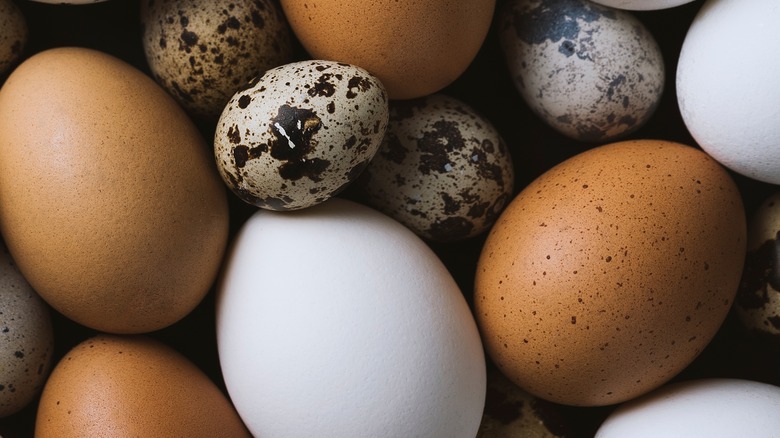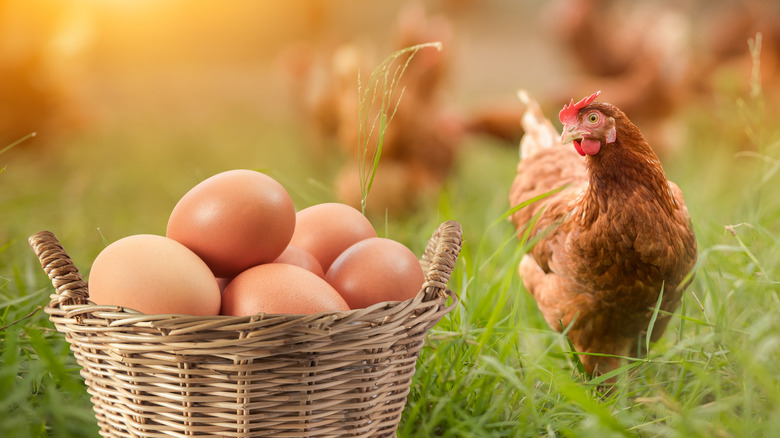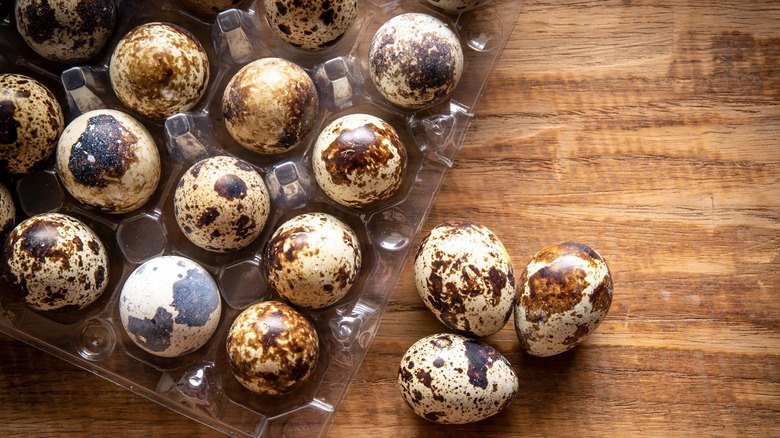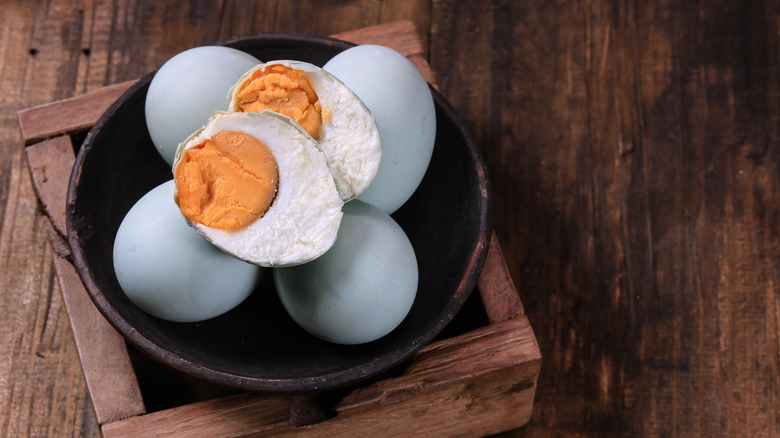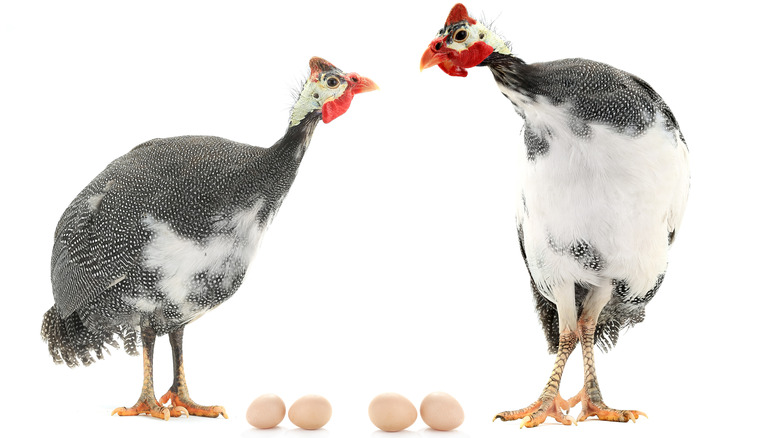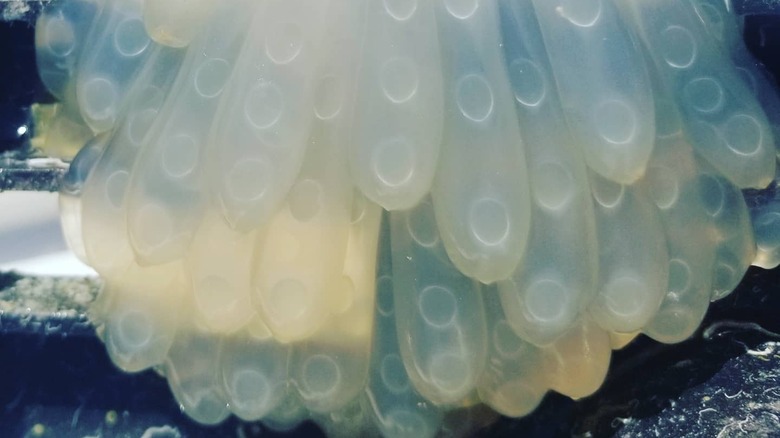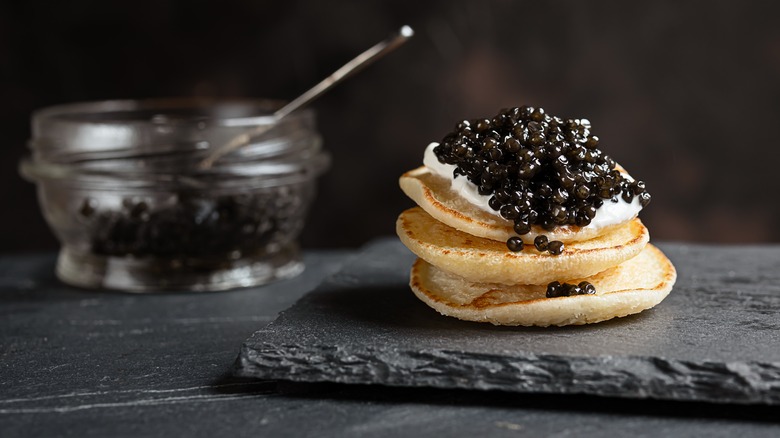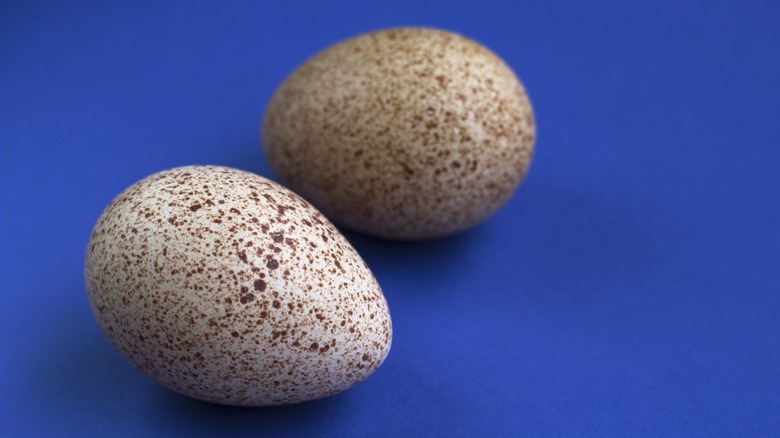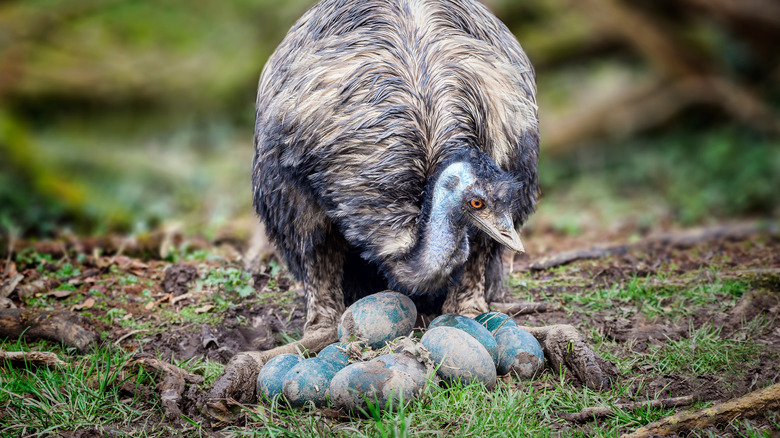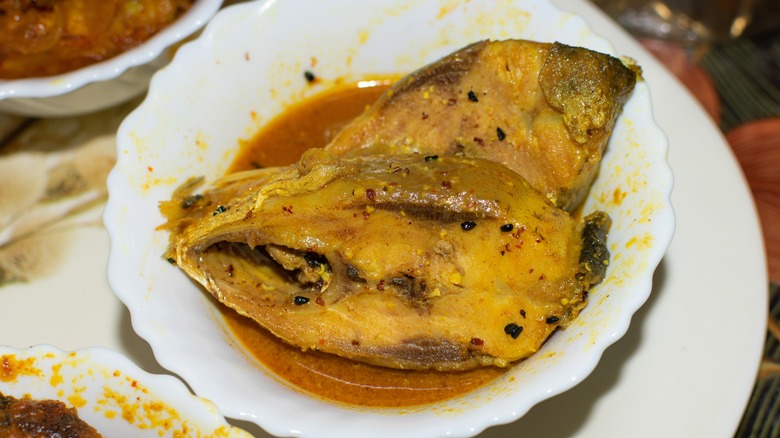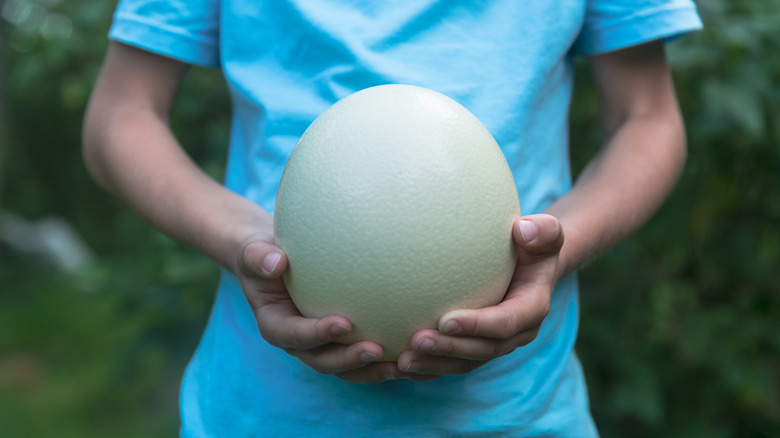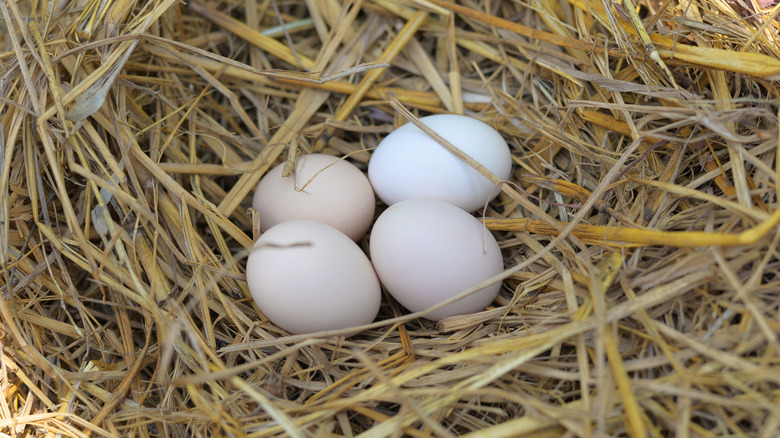14 Different Types Of Eggs And How To Cook With Them
We were going to tell you a joke about eggs to start this off but realized it wasn't all it was cracked up to be. And, with that terribly unfunny introduction, let's talk about eggs — the fundamental part of a good breakfast (or easy brunch!) in the United States and worldwide. They are an important ingredient in many dishes, including certain kinds of pasta, salads, dressings, and more. Eggs are used in sauces, casseroles, and baked goods of all kinds, in addition to being an any-time favorite. However you choose to prepare and eat them — whether scrambled, poached, fried, or mixed into an extra-moist butter cake recipe — eggs are a fantastic staple to have on hand (even if they seem to get more expensive by the hour).
Many people don't know how many different kinds of eggs are out there. Americans consume a hefty quantity of chicken eggs annually, and data from 2023 averages that the average person will eat over 280 eggs per year. But chicken eggs are hardly the only appetizing option. In addition to chicken eggs, many other egg varieties worldwide are just as delicious and just as popular in their respective locations. Here are 14 different types of eggs and suggestions on how to make them into a fabulous meal.
14. Chicken eggs
To start with a classic, beloved, and well-known egg, it can only be that of the chicken. Sold at most grocery stores across the country, chicken eggs are a go-to for meals of all kinds. A focal point of Easter decor and appetizers, and a staple at every breakfast restaurant, chicken eggs come in a few varieties related to how the chickens are raised. For instance, the supposed gold standard of chicken eggs is the coveted pasture-raised variety. Pasture-raised chickens can roam freely and eat as they would in the wild, with an organic diet of bugs and worms — delicious. Pasture-raised chickens also have ample access to sunlight, which helps the overall nutrition of their eggs. If you can't find (or afford) pasture-raised, you can also find free-range, conventional, organic, and cage-free options.
Once you've selected a type of chicken egg, the fun decision is how to prepare them, and there, you have nearly endless opportunities. You can use chicken eggs to make a scrumptious and fresh egg salad or a mouthwatering plate of perfectly scrambled eggs. Chicken eggs also work flawlessly in baked goods and anything else you can think of using an egg for. Essentially, chicken eggs boast wide versatility in the kitchen at one of the most affordable price tags, even with 2023 prices. So what are you waiting for? Don't be a chicken — get some chicken eggs and feast to your heart's content.
13. Quail eggs
If you are familiar with quails, you know that they are precious, small birds with a colorful plumage and a cute, hat-like feather that sets them apart in the animal world. As stylish as these avian fashionistas are, they also make some delicious eggs. Quail eggs, while not as common as chicken eggs, are an excellent option to switch up the egg monotony or to impress your guests with a unique protein. Renowned chef Jamie Oliver is a big fan of quail eggs and raises quails of his own, which is just adorable.
Oliver prepares quail eggs by frying them, making them into omelets, or scrambling them. He also enjoys boiling the eggs but highlights that peeling can be challenging. Quail eggs require more hands-on finesse to peel and prepare than their chicken counterparts due to being much smaller and, therefore, more delicate.
To take on the challenge of boiling them, follow these tips. Quail eggs are much more petite than chicken eggs, so you should boil them in a pan instead of a pot. Ensure that the water covers the eggs entirely, and add them in after reaching a roiling boil. From there, the eggs should boil for two minutes for soft-boiled, three for medium, and three and a half minutes for a hard-boiled texture. After your timer goes off, move the delicate eggs into a bowl of ice water. This will stop them from cooking further and help them cool so you can peel them burn-free.
12. Duck eggs
You can also venture into duck territory for a boost in nutrition and a change of pace from chicken eggs. How? Go outside, quack loudly, and a duck will flock nearby to battle you for its eggs. Or, the easier option is to go to the store to get some, with no duck fight required. Once you've acquired the duck eggs, you can begin the preparation of your nutrition-packed meal and rest easy because duck eggs provide protein, vitamin A, vitamin B, and omega three fatty acids, all of which are healthy additions to any diet.
Duck eggs are nearly double the size of chicken eggs and can be easily scrambled, fried, or boiled. To enact your creative culinary prowess, however, you can also poach, slow-cook, or feature them in fancy dishes by taking advantage of their large yolk with salt-and-sugar-cured yolks. To add a boost of Asian flare, why not try a Chinese-salted duck egg? With its traditional origins comes a unique method of preparation that includes sunbathing the eggs (yes, sunbathing), incorporating imported Chinese liquor, and letting the eggs age for nearly a month. This method of preparation is a real culinary adventure and results in a lovely umami flavor, with less density than a boiled chicken egg and a soft yolk that tastes somewhat like chestnut. For adventurous chefs, salted duck eggs are a pursuit worthy of immense bragging rights.
11. Alligator eggs
Eggs come in many shapes and sizes and from many different creatures, both friendly and threatening. An egg from the riveting nest of danger is the alligator egg. If the risks of daily cooking aren't enough to get your blood pumping, perhaps alligator eggs will add a bit of zest to your routine and menu. Alligator eggs are surprisingly popular among the groups licensed to go after them, bringing us to the cautionary tangent of this article. Please do not hunt for alligator eggs unless you have the proper licensing and permits to do so. Violators could face jail time and serious fines, which aren't fun. Now you know. Plus, you may run into an angry alligator mother. No one wants that.
For the approved alligator egg hunters, these eggs can be exciting both during the harvest and afterward. Many collectors of alligator eggs actually aim to hold onto them until they hatch, as they often will be destroyed if left to the elements. Alligator eggs can be prepared differently for those who choose to eat them, and pickling is one of the most popular methods. To pickle your alligator eggs, boil them like a chicken egg, and mix up vinegar, water, and your chosen spices. Remember to utilize proper and safe canning techniques, and place the jarred eggs with their flavored mixture into the refrigerator for at least a week. This will allow the eggs time to absorb the flavors. Then, enjoy your perfectly brined and pickled alligator eggs at room temperature or right out of the fridge.
10. Guinea fowl eggs
Guinea fowl are another type of bird, native to Africa, that can be raised for their eggs. They are smaller than a turkey, larger than a chicken, and great flyers. Generally, you won't find guinea fowl eggs in your typical supermarket or grocery store, but you may have luck if you look at your local Asian markets, which carry more unique eggs. Interestingly, guinea fowl do not lay eggs throughout the year as chickens do. They only lay eggs from March to October and don't produce endless eggs — only about 100 eggs each season. The eggs themselves are smaller than chicken eggs but have a similar yolk to whites ratio and taste almost indistinguishable from chicken eggs.
To prepare them, you can treat them as you would chicken eggs. Scramble, fry, bake, poach, and more, and they will tolerate the preparation well. You can choose from the range of delicious egg recipes out there and use guinea fowl eggs and chicken eggs interchangeably. They provide substantial protein and helpful minerals like zinc and calcium while staying low in carbs, so you can eat them essentially guilt-free. So, whether you opt for guinea fowl eggs benedict, guinea fowl breakfast casserole, or the impressive guinea fowl croque madame, you will surely wow your breakfast and brunch guests.
9. Octopus eggs
Walking through the more unique egg options, we have the translucent and oblong octopus eggs. Like a dish from a sci-fi film, an octopus egg is an exquisite delicacy that few have had the chance to put into their mouths. You can eat octopus eggs in the form of roe (similar to caviar) or as an entire egg sack of little octopus eggs, as was recently debuted on menus in Japan. The first form is often the more easily attainable. The entire octopus is cooked whole before the eggs are removed to prepare octopus roe. From there, octopus roe is often used to top sushi as a decoration or may serve as a sushi filler.
Consuming an octopus egg in its original, uncooked form is rare. To experience the unique and novel food, you need only to visit a fish market in Tokyo where you can obtain an entire octopus egg sac. Large, gelatinous, and perhaps slightly alien in the best way, this egg will cost you around 1,000 yen, the equivalent of roughly seven US dollars. Covered in a gooey, surprisingly thick membrane, the octopus egg will eventually burst to reveal tentacle-like insides. These are, of course, the actual octopus eggs, which do not need to be cooked and can, instead, be topped with soy sauce and scooped up with a spoon. The taste is similar to salmon roe. So, while octopus eggs may not be ideal for cooking at home, they are worth a try if you find yourself in Tokyo.
8. Pheasant eggs
Pheasants are unique birds with brightly colored heads and a turkey-like gait. They are found worldwide, and their eggs are commonly consumed. Pheasant eggs differ from their avian friends' eggs and are smaller, with a more distinct flavor. Their larger yolk is exceptionally creamy and thick, making it a perfect contender for certain recipes. Pheasant scotch eggs are a popular dish that can be served as an impressive appetizer or side dish. With a delicious mix of garlic and herbs, pheasant scotch eggs are deep-fried to perfection — even better when served with creamy garlic mayo. Scrumptious.
You can also use pheasant eggs in a lighter, spring-themed dish like an asparagus and pheasant egg salad, consisting of boiled eggs on top of fresh asparagus, paired with a dijon vinaigrette. Or, you can use pheasant eggs to make a decadent custard. With their larger and creamy yolk, about six pheasant eggs can yield a smooth and perfectly sweet vanilla custard and can be eaten either warm or cold. However you choose to indulge in the pheasant's rich eggs, you can't go wrong.
7. Caviar
Generally reserved for indulgent and impressive dishes, caviar is an expensive delicacy served across the globe. Formally speaking, caviar is only such if its origin is sturgeon eggs. However, that rule has become more flexible with time and has led the term caviar to include various types of roe, including salmon, flying fish, trout, and masago. With a high price tag, at nearly $600 for 17 ounces, caviar is quite simple to prepare. Set aside salt, the eggs of your choice, a mesh colander, a large bowl, and some jars for storage. Run the fish skin over the mesh to remove the eggs and wash them in salty water. Certain types of roe require different salt content, so research accordingly based on your preference. Then, the eggs need to dry out for a bit before they can be packaged or served.
Overall, the art of caviar preparation lies in the amount of salt used and the finer details. Once you've made it, you can pair caviar with crackers and sour cream, eat it on its own, or add it to a pasta dish. While merchants of pricey caviar would like to surround its origin in mystery and awe, the process of making the expensive dish is easily manageable, even for modest home chefs. Still, you don't have to tell your dinner guests how easy it is if you want to maintain the illusion of impressive expertise.
6. Goose eggs
You're absolutely a silly goose if you haven't tried goose eggs. We won't really judge, but we recommend exploring this delectable egg option. Goose eggs are larger than chicken eggs, with one egg yielding about the same as two to three chicken eggs. They also provide a rich and creamy taste and prestige, as they are rare. Goose eggs are rare partly due to their limited hatching season from March through June. Also, most farmers who breed geese and have access to their eggs won't sell them, as they profit more from goose meat after the goose matures.
If you do manage to snag a goose egg or two, you can prepare them in some tasty and fun ways, similar to how you might prepare chicken, duck, or quail eggs. A goose egg can be boiled quite successfully, used in an omelet, or scrambled. Cooking the goose egg to a soft-boiled consistency will showcase its creamy texture while creating a delicious dipping sauce for its accompanying vegetables or accouterment.
5. Turkey eggs
Gobble gobble, it's turkey time. Turkey egg time, anyway. For a smidge of trivia about them, turkeys lay a full group of 9-13 eggs within the span of about 28 days. During this time, the turkeys face various dangers from predators, which often hinders the success rate of turkey eggs fully hatching. This makes turkey eggs a bit more complicated to come by, but not impossible by any means. You can usually find turkey eggs at specialty markets or from your local turkey farmers. Once you've acquired your speckled turkey eggs, you can fire up the stove and start cooking.
Turkey eggs take well to boiling at various textures and also work well in recipes that call for chicken eggs. For instance, you can easily make vanilla bean cupcakes using turkey eggs and won't even be able to tell the difference between using a chicken egg. Otherwise, you can use turkey eggs for egg salad, casseroles, custards, and anything else that suits your fancy. Just be sure you compensate for their size, which can be twice as large as chicken eggs.
4. Emu eggs
From the giant birds come giant eggs. One emu egg is equivalent to a full dozen chicken eggs, which is quite impressive. With one egg to feed up to six people, emu eggs also boast a slightly creamier texture than chicken eggs and a different yolk-to-white ratio, with a smaller yolk. Otherwise, the taste is mild and similar to chicken eggs.
Emu eggs can be prepared in various ways and can easily serve a brunch-eating crowd. Consider making it into a frittata to whip up a tasty emu egg dish. Also, consider placing it next to your largest avocado for comparison, just for fun. Preparation of an emu egg frittata is simple once the egg is opened. Emu eggs have fairly tough shells, so a neat and tidy way to open them is to drill a hole in the top. From there, you can pour its contents into the bowl for scrambling. Then, you can cook it up with vegetables and add your other toppings. We like mushrooms, onion, bacon, and cheese. For another fun emu egg recipe, you can try emu egg fondue, which pairs the creamy inside of the egg as a sort of fondue dip for potatoes, sausage, and a baguette.
3. Hilsa
Hilsa is a popular fish in South Asia and is especially revered in Bangladesh, where it is called Elish mas, or "the queen of fishes." The fish itself is a widely eaten item, but the eggs or roe of the hilsa fish is equally as popular, if not more. The fish and its eggs are known for their special and different taste and texture and are utilized in various recipes.
A popular way of preparing hilsa eggs is to fry them whole in their egg sack. Similar to the octopus egg, but not quite as unique, hilsa eggs in their pouch are about half the size of your palm and shaped like a lima bean. Ilish Macher Dim Bhuna is a popular dish for fried hilsa eggs, which brings together warm flavors like turmeric, chilis, and cumin. Alternatively, you can prepare them fried with a curry or green chutney. Either way, you will have created a well-loved South Asian dish with a unique fish egg.
2. Ostrich eggs
Ostriches are the largest and fastest birds, with the largest egg of any bird. One ostrich egg weighs about three pounds, equivalent to 20 chicken eggs. Wow. With that caliber of size, it's no wonder that ostrich eggs are a popular option for cooking. Their flavor is very similar to chicken eggs, with some people reporting a slightly sweeter flavor. One ostrich egg contains nearly 180 grams of protein, which is enough to satiate even the hungriest athlete. When one egg can feed your entire horde, it seems to be a worthwhile investment, especially considering how versatile they are in different recipes.
An easy and satisfying ostrich egg recipe is a classic omelet. Granted, this won't be your ordinary omelet. It will be gigantic, requiring a suitably sized pan and serving plate. However, ostrich eggs pair well with most flavors, so you can add toppings and ingredients to the omelet as you and your friends or family prefer. Additionally, you can scramble an ostrich egg, again taking into consideration the additional cooking time and large dishes that will be necessary.
1. Bantam eggs
Coming full circle from our start with chicken eggs, we have Bantam eggs from Bantam chickens, which are essentially smaller-than-normal chickens. They are cute, fluffy, and popular for homesteaders, as they are easy to raise and yield eggs with little difficulty. Their eggs are colorful, like chicken eggs, and about half as large with larger yolks and a slightly richer flavor.
With their similarity to chicken eggs, they go well in a similarly wide array of recipes and can be prepared in a number of ways. You can prepare a soft-boiled bantam egg salad, where the soft-boiled eggs are the star, atop a bed of arugula or fresh greens. Or, you can invest a bit more time into Bantam-egg tartines, which consist of Bantam-egg salad on top of toast — simple and delightful. Undoubtedly, Bantam eggs are another popular egg option that is sure to supplement your diet with lovely and scrumptious recipes.
